My Helmet Mirror Manifesto
A mirror?
For me?
On my helmet?
Ya gotta be kidding.
Back in the day
When I was a hot-shot, I wanted to be the next Greg LeMond (I know, I’m dating myself). I stripped every nonessential gram from my Italian racing steed, so I could go that much faster. I actually looked into how I could inflate my razor-thin tires with helium, so I could shave off another fraction-of-a-fraction-of-an-ounce.
A mirror on my helmet? Pfff. I was too cool to even wear a helmet, let alone put a dorky mirror on it. None of the professional cyclists I idolized even wore helmets, let alone helmet mirrors. And I was practically one of them.
My cycling spidey sense was so sharp…
…I didn’t need a mirror on the helmet I didn’t wear. My ears told me the make, model, year, closing speed, and passing clearance of whatever was behind me. Oh, yeah, my ears knew the color of the vehicle behind me, too. Amazing!
What can I say? I was an over-confident teenage boy with an overabundance of derring-do — and a decided lack of humility. Yes, I could hear an approaching vehicle, and even be able to guess pretty accurately whether it was a sedan or a semi. But that’s nothing special if you have average hearing, which mine most assuredly is. Ask my wife.
Maybe hearing is good enough…
…if all you ever do is hug the edge of the road (and pray for your life as you hear a roaring engine barrel toward you). Your hearing might be all you ever need if you never leave the edge to make a turn, change lanes, or avoid a hazard. Or if you don’t mind getting your legs shaved by the land rocket that just buzzed you.
If you’d like more space, read on.
First, understand this:
When you choose to ride on the edge, you’re irrelevant.
This is one of the most important things I learned when I encountered CyclingSavvy. The more relevant you are to motorists, the more you influence their choices. Where are you more relevant? Somewhere away from the edge.
Every time you glance over your shoulder, you take your focus away from where it’s most needed: In front of you.
The exact location away from the edge depends. That’s the next thing I learned from CyclingSavvy: How to think critically about the road and the traffic on it. How wide is the lane? Can I safely share it with a car? An F-150? A semi? How heavy is traffic? How fast? What conflicts am I vulnerable to? How can I reduce my risk? What’s my cycling behavior communicating to others?
It’s OK to ride far to the right, if many conditions are met.
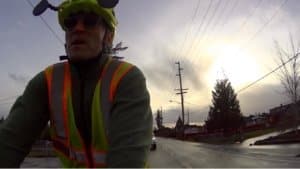
Can you see the car behind me? I can, too!
Often, though, it’s not OK. It’s more dangerous to be on the edge than in the lane of traffic. With savvy cycling know-how, I learned how to tell where I should drive — yes, drive — my bicycle.
This is CyclingSavvy’s other big takeaway: Cyclists who adopt driving behavior — rather than edge behavior — are more visible, less prone to conflict, and more relevant to others on the road. They also get where they’re going faster and more directly.
Oh, and they have more fun.
What does this have to do with bicycle helmet mirrors?
Think about it. Do you need mirrors on your car? On your motorcycle? Yes, of course. They’re required by law, and for good reason. Drivers need to be able to see all around them in order to change lanes and make turns.
Bicycle drivers are no different. Unlike car drivers, though, we have a built-in advantage. Because we’re not encased in a steel and glass box, we have much more ability to know what’s going on around us. My teenage self was spot on: you can hear what’s coming from behind you. Seeing what’s behind you is pretty simple, too. Just glance over your shoulder.
Here’s the thing, though. Every time you glance over your shoulder, you take your focus away from where it’s most needed: In front of you.
Me and my helmet mirrors. Yes, mirrors.
I love — and I mean capital “L” LOVE — my helmet mirrors. Yeah, that’s plural. I have one on my left, and one on my right. I often need to change lanes to the right. A mirror on the right gives me a quick check of what’s behind me on my right.
(If my know-it-all doofus teenage wannabe racer self could see me now, his eyes would roll right out of his head.)
With mirrors, I keep my focus in front of me more of the time because I can just move my eyeballs instead of having to move my whole head — or in my case, my whole upper body, since I’m not quite as limber as I used to be.
Whether you use a mirror or not, ALWAYS look over your shoulder before making a lateral move.
By taking a quick look in my mirrors, I get a preview of what’s going on behind me. I can read the behavior of the drivers behind me and see in real time how they’re responding to me.
Note that I used the word preview. Before changing lanes or lane position, I always look over my shoulder as well.
I’ll say that again. It’s super important.
Whether you use a mirror or not, ALWAYS look over your shoulder. Turn your head or torso to see what’s behind you before you change lanes or lane position.
A mirror can be helpful, but it’s not a good substitute for a head turn.
Why should you look over your shoulder if you have a mirror?
“Shoulder Check” a crucial savvy cycling skill
“A mirror can be helpful, but it’s not a good substitute for a head turn,” said CyclingSavvy co-founder Keri Caffrey.
During the parking lot skills session, CyclingSavvy instructors work extensively with their students on “Shoulder Check.” Being able to look over your shoulder while keeping a straight line does several things: It helps you check for traffic. It establishes your humanity and allows you to communicate with others. Also, you don’t want to “wobble” when you’re out and about (and we show you how not to). Riding straight is important for predictability and respect from others.
“A good head turn is a tool for getting drivers to notice that you want to do something,” Keri said.
“When you turn your head over your shoulder, more often than not, other drivers will help you out if they can.”
It’s a skill that doesn’t come naturally, even for bicycle safety experts.
“I didn’t develop a good shoulder check until I rode without a mirror for several months,” Keri said.
Why I became a helmet mirror fan
I came to CyclingSavvy already well established as a bicycle safety expert. Yet a huge “Ah-Ha!” moment for me was learning the strategy of “Control & Release.”
CyclingSavvy taught me that I have a right to use the road, and that cowering on the edge doesn’t do me or anybody any good. But in addition to that, I learned how to claim my rightful road space and cooperate with other drivers as I control my space.
This is the essence of Control & Release. With helmet mirrors, it’s a lot easier.
Here’s how: Let’s say I’m riding down Perry Avenue near my home. Like most roads around here, it’s a 2-lane road with 11-foot lanes, too narrow to share.
There’s no way I’m going to “get out of the way” and “share” a lane with that 10-ton behemoth, so I calmly give everyone The Hand.
I make myself relevant by riding in the middle of the lane, so it’s obvious to drivers who want to overtake me that they’ll need to change lanes to pass. This is the passive communication that our lane position always gives.
As I ride along, I glance at my mirror and see a car approaching me quickly. I glance again, and see that the driver has slowed down. She’s hanging back, patiently waiting for a safe opportunity to pass.
Motorist Eternity
After a few moments, I take another look in my mirror. Now I see a monster truck stacked up behind the nice patient lady. Monster Truck is not happy with the delay. It’s been about 30 seconds — an eternity in “Motorist Years.”
I wave to Monster Truck and don’t get a return wave. That’s OK. I got what I wanted, which was my space.
“Motorist Eternity” — also known as Must Pass Bicyclist Syndrome — happens when a motorist finds him- or herself “stuck” behind a bicyclist. Motorist Eternity can kick in as early as five seconds of being “stuck” behind the bicyclist.
(Funny how Motorist Eternity never kicks in at red lights. Motorist Eternity doesn’t appear to afflict drivers completely stopped in interstate traffic jams. No bicyclists there. Hmmmm.)
The nice lady’s patience is starting to wane.
But it’s the driver of the monster truck who I’m really thinking about. Sure enough, at Second 31, Monster Truck starts scooching over to pass both of us, even though there’s an oncoming car.
There’s no way I’m going to “get out of the way” and “share” a lane with that 10-ton behemoth, so I calmly give everyone The Hand.
I just hold my hand there and glance in my mirror again.
“The Hand” is the universal hand signal for “stay back,” left arm extended diagonally out, palm back. Sure enough, Monster Truck moves back into the lane. That driver is not happy, but gave me what I wanted, because I asked.
I knew to ask because I could read their behavior in real time by looking in my mirror. Passive communication with my lane position wasn’t enough. I needed active communication too.
The Hand, the Come Along Wave, and Thank You Wave
Fortunately, there’s a usable shoulder coming up, so I retract The Hand, and give a right-turn hand signal as I maintain lane control. When the shoulder opens up, I look over my right shoulder, move to the right, stop pedaling, and give everyone the Come Along Wave, left hand making a circular motion in a “come along” kinda way.
As the nice lady starts to pass me, I now give her the Thank You Wave. She waves back!
I wave to Monster Truck, too, and don’t get a return wave. That’s OK. I got what I really wanted, which was my space.
After Monster Truck passes, I glance in my mirror again, see nobody behind me, do a shoulder check, give a left-turn hand signal, do another shoulder check (since my arm is already out anyway), and move left into the middle of the lane.
Those dorky helmet mirrors give me the awareness I need to be able to mix and mingle with traffic in a fluid, harmonious way.
In all of this, the mirror allowed me to see how drivers were responding to me without me taking my focus away from where I was going. My mirrors also gave me a first glimpse prior to my shoulder checks as I prepared to make lane position changes.
It’s certainly possible to do Control & Release without using mirrors. It’s just that without a mirror, you’ll spend an awful lotta time looking over your shoulder…over and over…each time you want to see what’s happening back there. No fun!
Act like a driver to be treated like one.
The more relevant you make yourself, the more you are respected. Using “driver behavior” makes it easier to see what’s happening around you, so you’re able to respond more quickly to dynamic situations.
Why every ride is a joyride.
My mirrors are key to my safety and success on my bike. It’s why every ride is a joyride. Because, yes, those dorky mirrors on my helmet give me the awareness I need to be able to mix and mingle with traffic in a harmonious, responsive way.
My bike is no longer a stripped-down thoroughbred. I always wear a helmet now. My younger self would be embarrassed to be seen with me.
But if I had the chance to take my younger, sportier self out for a ride, I think even he’d be impressed with that middle-aged guy with the dorky mirrors, riding with grace and confidence, hardly ever getting buzzed, fluidly cooperating with traffic, glancing back occasionally in his mirrors to see if that young racer know-it-all is keeping up.
Brian’s Holiday Gift to ABEA
That’s right! For the same price you’d pay online for one of these fantastic mirrors, you’ll be helping ABEA spread savvy cycling to more people.

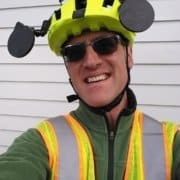
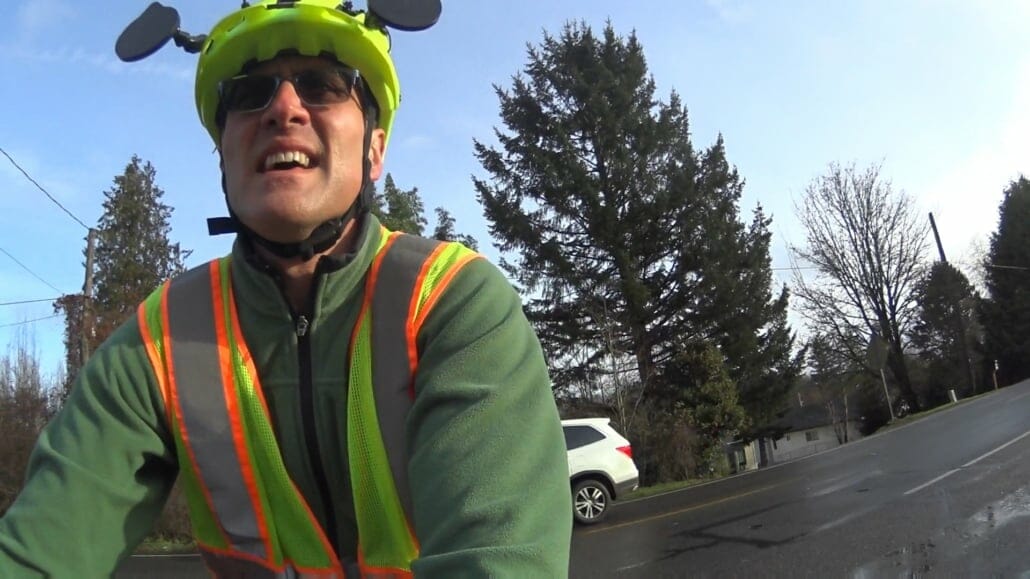

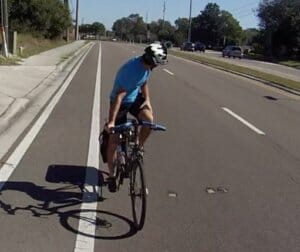

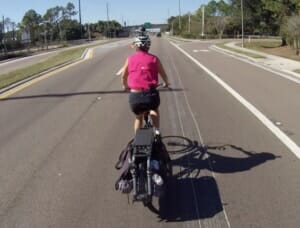
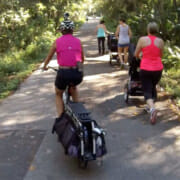

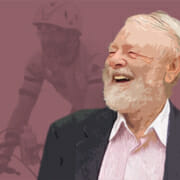
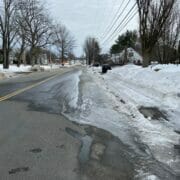
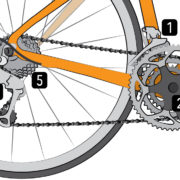

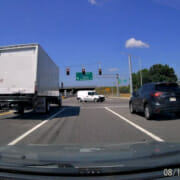
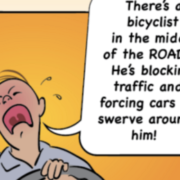



In my “salad days” several decades ago, neither I nor any other bicyclist whom I knew gave a second thought to something as strange as a rear-view mirror. And not only were helmets rarely worn, but even lights were used quite infrequently, if at all. Unlike Brian, I never aspired in the least to be a racer but remarkably I did ride a fast bike: A Viscount, thankfully the post-“death fork” model. And like almost all other commuters whom I knew, I was an “edge rider.”
Today, as Brian’s experience so well indicates, a helmet, a rear-view mirror, and redundant lighting are all indispensable features of most of our two-wheeled commutes. Perhaps John S., John A., or some other bicycle scholar on this list can detail for us the process whereby all of this equipment has moved from the margins to the mainstream. It can’t all be explained by the “older and wiser” mantra. Sadly, “edge riding” has yet to go the other way, from the mainstream to the margins, where it properly belongs most of the time. (In the absence of Cycling Savvy, I learned my lesson in the School of Hard Knocks, Asphalt, & Concrete over 40 years ago when the Viscount’s front wheel locked in a sewer grating, sending me over the handlebars and to the emergency room!)
My deepest thanks to Brian for becoming not only the “mirror-image” :-) of the rider that he was in his youth but also for his remarkable generosity!
Thanks, Harold! Here’s to learning from our experiences, both good and not-so-good.
Aren’t you concerned about forward blind spots? I get the gist that the mirrors are your style, so I won’t go into expounding on all of the other mirror options that are out there and how they make work better for others than your choice, but blind spots would be my concern. Big blind spots.
Todd,
Thanks for commenting on my piece. In my experience, forward blind spots are not an issue. With the mirrors positioned correctly for me to easily see behind me, they are not in my primary focus area. They are up and slightly to the left and right. I’ve never had any problems seeing where I’m going with these mirrors on my helmet. In my experience, the advantages outweigh any disadvantages, such as whatever sight obstruction there might be to my front because of them. But, again, I’ve never experienced any relevant sight obstruction with these mirrors.
The advantage of this particular mirror (EVT) is that it has a large mirror diameter, which gives me as full of a view of what’s behind me as a mirror can. The other advantage of this particular mirror is that it stays in place and doesn’t blow around in the wind or get knocked out of position easily. I’ve gone through several other helmet mirrors that had these problems, and I’m glad to have found one that doesn’t.
Having said all that, I grant that helmet mirrors are not for everyone. They weren’t for me for a long time. I recommend that people try lots of different options, and pick which one works best, if at all.
Thanks again!
There are no forward blind spots, even with two mirrors. They are usually high enough in the visual field not to block the view of the road ahead. Also, they are in different locations in the forward visual field, so a mirror user can shift attention from one eye to the other and look “through” a mirror with the opposite eye. That may sound spooky because there is no external evidence of it, but it is real. And turning the head moves the mirrors around even while the eyes can keep looking in the same direction. I have a few times had an issue with focusing attention on my mirror and missing something ahead — much less of an concern though than with a shoulder check.